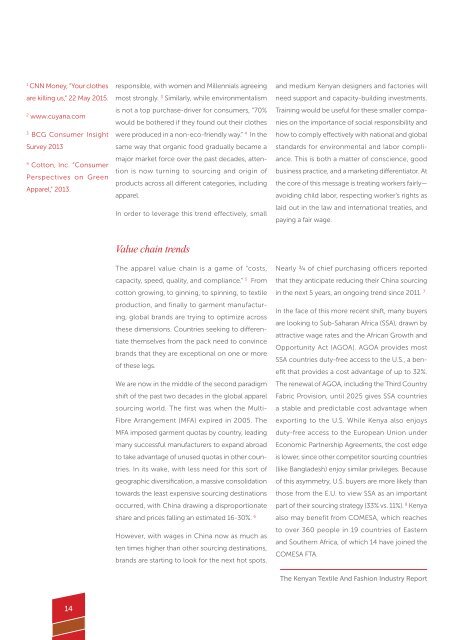You also want an ePaper? Increase the reach of your titles
YUMPU automatically turns print PDFs into web optimized ePapers that Google loves.
1<br />
CNN Money, “Your clothes<br />
are killing us,” 22 May 2015.<br />
2<br />
www.cuyana.com<br />
3<br />
BCG Consumer Insight<br />
Survey 2013<br />
4<br />
Cotton, Inc. “Consumer<br />
Perspectives on Green<br />
Apparel,” 2013.<br />
responsible, with women and Millennials agreeing<br />
most strongly. 3 Similarly, while environmentalism<br />
is not a top purchase-driver for consumers, “70%<br />
would be bothered if they found out their clothes<br />
were produced in a non-eco-friendly way.” 4 In the<br />
same way that organic food gradually became a<br />
major market force over the past decades, attention<br />
is now turning to sourcing and origin of<br />
products across all different categories, including<br />
apparel.<br />
In order to leverage this trend effectively, small<br />
and medium Kenyan designers and factories will<br />
need support and capacity-building investments.<br />
Training would be useful for these smaller companies<br />
on the importance of social responsibility and<br />
how to comply effectively with national and global<br />
standards for environmental and labor compliance.<br />
This is both a matter of conscience, good<br />
business practice, and a marketing differentiator. At<br />
the core of this message is treating workers fairly—<br />
avoiding child labor, respecting worker’s rights as<br />
laid out in the law and international treaties, and<br />
paying a fair wage.<br />
Value chain trends<br />
The apparel value chain is a game of “costs,<br />
capacity, speed, quality, and compliance.” 5 From<br />
cotton growing, to ginning, to spinning, to textile<br />
production, and finally to garment manufacturing,<br />
global brands are trying to optimize across<br />
these dimensions. Countries seeking to differentiate<br />
themselves from the pack need to convince<br />
brands that they are exceptional on one or more<br />
of these legs.<br />
We are now in the middle of the second paradigm<br />
shift of the past two decades in the global apparel<br />
sourcing world. The first was when the Multi-<br />
Fibre Arrangement (MFA) expired in 2005. The<br />
MFA imposed garment quotas by country, leading<br />
many successful manufacturers to expand abroad<br />
to take advantage of unused quotas in other countries.<br />
In its wake, with less need for this sort of<br />
geographic diversification, a massive consolidation<br />
towards the least expensive sourcing destinations<br />
occurred, with China drawing a disproportionate<br />
share and prices falling an estimated 16-30%. 6<br />
However, with wages in China now as much as<br />
ten times higher than other sourcing destinations,<br />
brands are starting to look for the next hot spots.<br />
Nearly ¾ of chief purchasing officers reported<br />
that they anticipate reducing their China sourcing<br />
in the next 5 years, an ongoing trend since 2011. 7<br />
In the face of this more recent shift, many buyers<br />
are looking to Sub-Saharan Africa (SSA), drawn by<br />
attractive wage rates and the African Growth and<br />
Opportunity Act (AGOA). AGOA provides most<br />
SSA countries duty-free access to the U.S., a benefit<br />
that provides a cost advantage of up to 32%.<br />
The renewal of AGOA, including the Third Country<br />
Fabric Provision, until 2025 gives SSA countries<br />
a stable and predictable cost advantage when<br />
exporting to the U.S. While Kenya also enjoys<br />
duty-free access to the European Union under<br />
Economic Partnership Agreements, the cost edge<br />
is lower, since other competitor sourcing countries<br />
(like Bangladesh) enjoy similar privileges. Because<br />
of this asymmetry, U.S. buyers are more likely than<br />
those from the E.U. to view SSA as an important<br />
part of their sourcing strategy (33% vs. 11%). 8 Kenya<br />
also may benefit from COMESA, which reaches<br />
to over 360 people in 19 countries of Eastern<br />
and Southern Africa, of which 14 have joined the<br />
COMESA FTA.<br />
The Kenyan Textile And Fashion Industry Report<br />
14


